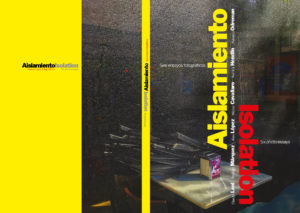Aislamiento: seis ensayos fotográficos / Isolation: six photo essays
|
Aislamiento: seis ensayos fotográficos / Isolation: six photo essays Descripción técnica:
Autores:
Extracto del prólogo: « Alejados – voluntaria o involuntariamente – de una ciudad [Caracas] tan efervescente como decadente en su modernidad en ruinas, las visiones de este trabajo adquieren en un sentido el aura del outsider y la mirada détachée en sus respectivas ciudades de acogida. […] Es importante precisar que estas imágenes no son la consecuencia de un proyecto fotográfico planificado. Al contrario, el proyecto es el resultado de una formalización a posteriori a partir de las primeras capturas, cronológicamente hablando, hechas espontáneamente: de cierta manera, el trabajo consistió en un intento por comprender y desarrollar ese “inconsciente visual”, del cual habla Walter Benjamin, que se encontraba alojado en ellas. […] cada serie encarna en cierta medida la figura del flâneur baudeleriano, el caminante errático, ese ojo curioso urbano que en su paseo nihilista descubre un universo en cada objeto mientras serpentea multitudes. Lo particular de este caso, es que el flâneur está confinado, sometido a una introspección involuntaria. En sus caminatas privilegiadas en el mundo exterior, se asombra, ya no de aquellos objetos que testimonian de la Era Industrial, sino de arquitecturas vacías y de las esquinas aún verdes de una atmósfera cuasi postapocalíptica. » “El privilegio de las imágenes”/ “The privilege of images” Prologue (extract): « Distanced – willingly or unwillingly – from a city [Caracas] both bustling and in decay with its modernity in ruins, the visions of this work acquire an outsider’s aura and a detached regard in the photographers’ respective cities. […] It’s important to point out that these images are not the result of a planned photographic project. On the contrary, the formalization of the project came later, based on those first shots that were taken spontaneously. In a certain way, the work consisted in trying to understand and develop the “visual subconscious” that Walter Benjamin was talking about, and that was lodged in the pictures. […] each series embodies in its own way the figure of Baudelaire’s flâneur, the erratic idler, that inquisitive urban eye that, in its nihilistic stroll, discovers a universe in each object while it meanders among the crowds. What’s particular about this case is that the flâneur is confined, he’s subjected to an involuntary introspection. In his privileged walks in the outside world, he’s astonished, but not by the objects that bear witness to the Industrial Age, but by the empty architectures and the green spots that still remain in an almost post-apocalyptic atmosphere. » “El privilegio de las imágenes”/ “The privilege of images”
Tweet
|
